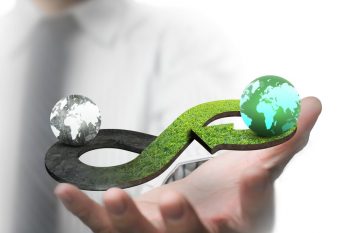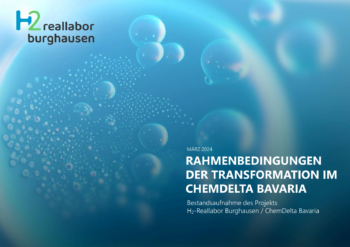Series of articles Carbon Management: How can CO2 be captured?
With the European climate neutrality targets for 2050 firmly in place, carbon management is moving into the focus of sustainable environmental practices. The challenge is not only to reduce emissions, but also to effectively manage unavoidable emissions. This requires the use of carbon capture technologies that enable either underground storage (Carbon Capture and Storage – CCS) or integration into a closed carbon cycle (Carbon Capture and Utilization – CCU). This series of articles provides an overview of carbon capture technologies, possible utilization of CO2, storage methods, transportation options and political efforts in the context of carbon management.
Contents of the article series
CO2-Capture: With pathways are possible?
In principle, there are the following two procedures for CO2 capture (see Figure 1): On the one hand, CO2 can be captured at single point sources, such as industrial combustion processes, before the exhaust gases escape into the atmosphere; on the other hand, CO2 already contained in the atmosphere can be removed from it. Biomass utilization represents a special case between these two paths. During growth, plants absorb CO2 from the atmosphere and bind it. When biomass is burned, this CO2 is released again, but can be captured at the point source before being released into the atmosphere.

Generally speaking , the higher the CO2 concentration in the gas stream, the lower the energy required for CO2 removal, meaning that highly concentrated point sources are preferable. Other target values for capture are to achieve both the highest possible CO2 yield and high purity. However, particularly with regard to the purity of the separated CO2 stream, the energy required for CO2 treatment increases disproportionately with increasing purity requirements.
CO2-Capture at single point sources: Industry, energy sector, waste incineration
CO2 capture processes at point sources are generally divided into three groups based on the underlying operating principles (see Figure 2): Pre-combustion, oxyfuel-combustion and post-combustion processes ([1], [2], [3]). Various technical designs are known for each group.

Pre-Combustion-processes separate carbonaceous components from the fuel before combustion so that no CO2 is produced during combustion itself. For this purpose, the fuels are gasified to produce synthesis gas, consisting mainly of CO, CO2, H2 and H2O. The proportion of carbon dioxide (CO2) and hydrogen (H2) in the gas mixture is increased by means of a water-gas shift:
![]()
The CO2 can then be separated by physical or chemical absorption. After the removal of further impurities, almost pure hydrogen remains, which then burns without further CO2 emissions. This group of processes is therefore unsuitable for processes that produce not only energy-related but also material or process-related emissions.
Oxyfuel-Combustion refers to combustion under an almost pure oxygen atmosphere and with partial exhaust gas recirculation. As a result, an (almost) complete combustion of the hydrocarbons into water and CO2 is achieved, so that a concentrated CO2 gas stream remains after condensation of the water vapor.
Post-Combustion-Processes are the most technologically advanced CO2 capture processes to date. After combustion and flue gas cleaning, the CO2 is separated from the remaining flue gas. This is typically done by chemical absorption (e.g. in amine scrubbing), physical absorption (e.g. to selexol) or adsorption (e.g. to zeolites). In these processes, the loaded sorbents must then be regenerated using energy, for example by increasing the temperature or lowering the pressure. Selective membrane processes or cryogenic liquefaction are also possible.
CO2 capture can be used for various processes in industry and the energy sector. However, the principle is that the use of CO2 capture should be kept to a minimum and is not a substitute for other deeper greenhouse gas reduction measures.
Following this principle, CO2 capture is particularly useful for industrial processes with process-related emissions. Process-related emissions arise from the raw materials used and therefore cannot be avoided by changing energy sources. For example, the production of quicklime (CaO) from limestone (CaCO3) necessarily produces CO2:
![]()
This makes lime burning, like the production of cement clinker, one of the industrial processes predestined for CO2 capture. Other processes, such as glass or brick production, also cause CO2 emissions caused by raw materials and are therefore also suitable for CO2 capture. However, due to the low absolute emission volumes and CO2 concentrations occurring at the individual sites, CO2 capture is not yet an economical option.
In the energy industry , waste incineration plants are potential candidates for CO2 capture in the sense of a closed carbon cycle. Especially in the production of plastics from synthetic hydrocarbons (CCU), the carbon contained must be separated again during waste incineration in order to achieve greenhouse gas neutrality over the entire product lifetime. Furthermore, biomass power plants are one way to achieve negative emissions. For this purpose, the CO2 absorbed by the biomass during growth and released by combustion, as described above, is separated and stored permanently (BECCS: Bioenergy Carbon Capture and Storage). The same applies if CO2 capture is downstream in industrial processes with biomass used for energy. For other thermal power plants, e.g. gas or coal-fired power plants, CO2 capture is also theoretically possible, but from the point of view of the necessary move away from fossil fuels, it is not a sustainable solution and carries the risk of lock-in effects.
CO2 capture from the atmosphere
Natural CO2 sinks are the CO2 uptakes summarized in the LULUCF sector. These include, among other things, the carbon sequestration of biomass during the growth phase or the CO2 uptake and sequestration of peatlands. In these ways, CO2 is naturally removed from the atmosphere.
In addition, CO2 can also be removed from the atmosphere by technical means. The so-called Direct Air Capture (DAC) process sucks in ambient air and a sorbent absorbs the CO2 contained in it. In a further step, the sorbent must be regenerated in order to obtain the pure CO2. Even though no technology is yet commercially viable, two processes are emerging: In the low-temperature DAC process, the sorbent regenerates at approx. 100°C, in the high-temperature DAC variant at approx. 850°C [4].
Further Information
Literatur
[1] Evaluierungsbericht der Bundesregierung zum Kohlendioxid-Speicherungsgesetz (KSpG). Berlin: Bundesministerium für Wirtschaft und Klimaschutz (BMWK), 2022.
[2] Lübbers, Sebastian: Technische CO2-Senken – Techno-ökonomische Analyse ausgewählter CO2-Negativemissionstechnologien – Kurzgutachten zur dena-Leitstudie Aufbruch Klimaneutralität. Berlin: Prognos AG, 2021.
[3] The ECRA Technology Papers 2022 – State of the Art Cement Manufacturing – Current Technologies and their Future Development. Duesseldorf, Germany: European Cement Research Academy, 2022.
[4] Block, Simon: Direct Air Capture in Deutschland: Kosten und Ressourcenbedarf eines möglichen Rollouts im Jahr 2045. Wuppertal: Wuppertal Institut für Klima, Umwelt, Energie gGmbH, 2022.

